The Fujinon XF 60mm F2.4 R Macro Lens For The Fuji X-Pro1:
After a few weeks of using my Fuji X-Pro1, I must confess that this camera has really got a hold of me :). Yes, the X-Pro1 does have it’s drawbacks but what camera doesn’t? I’m just loving what I get out of this system. The X-Pro1 operates very similar to a rangefinder, and the photographs that it produces are just awesome. No great camera system will be complete without equally great lenses, and Fuji did not disappoint witht the XF 18mm F2.0 R lens and XF 35mm F1.4 R lens. Now, there is even more to love with the release of the XF 60mm F2.4 R Macro lens for the X-Pro1 system. But one wonders (at least I do 🙂 )…Was the 60mm macro worth the wait? How will the 60mm perform on the X-Pro1? Can I live without the 60mm if I already have the XF 35mm? Please read on to find out!
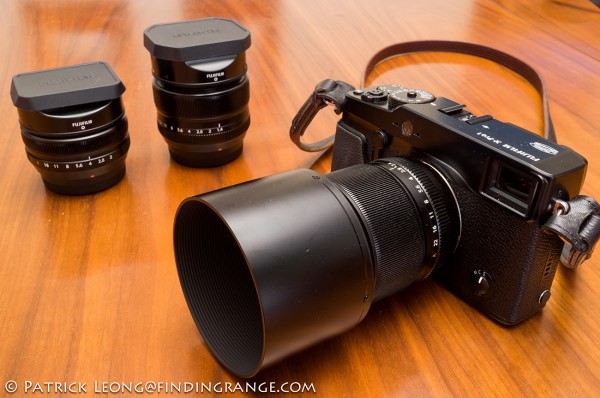
↑ The Fuji X-Pro1 system so far: From left to right – XF 18mm F2.0 R lens, XF 35mm F1.4 R lens, and the new XF 60mm F2.4 R Macro lens mounted on the X-Pro1.
Build Quality of the Fujinon XF 60mm F2.4 R Macro Lens:
Like the other two lenses in the X-Pro1 system, build quality of the XF 60mm F2.4 R Macro lens is excellent with no signs of loose parts, creaks or rattles whatsoever. In fact, at least with my copy of the 60mm, I find the build quality slightly better than the other two lenses that are offered for the X-Pro1. For instance, I find the aperture ring a bit smoother and tighter on the 60mm than both the 18mm and 35mm lenses. The 60mm also feels smoother when it is focusing especially when compared to the XF 35mm. It is less hollow sounding than the other two lenses when the autofocus is operating.
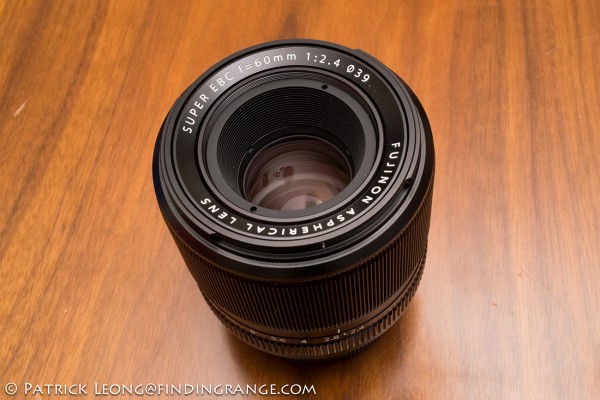
↑ Top view of the XF 60mm F2.4 R Macro lens.
But just like the other two lenses, the XF 60mm F2.4 R Macro lens is a bit light. Some will like this especially if you use your X-Pro1 all day. I myself prefer lenses that are a bit heavier. However, because of the lightness, I must admit that it’s pretty nice to carry the X-Pro1 system all day. There are many times when I carry all three lenses with my X-Pro1, and I honestly don’t feel any fatique at the end of the day.
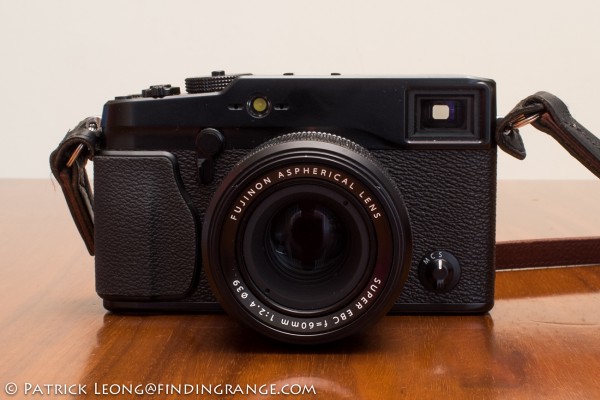
↑ Front view: XF 60mm F2.4 R Macro lens mounted on the Fuji X-Pro1.
In terms of feel, the XF 60mm F2.4 R Macro lens is very well balanced in the hands when it is mounted to the X-Pro1 especially for a 90mm equivalent. First off, it’s not much bigger than the 35mm, which is a good thing. Because of the lightness, the 60mm does not make the X-Pro1 front heavy. This is where the lightness of the whole X-Pro1 system is really beneficial. It’s great to use a 90mm equivalent lens on a rangefinder styled body without feeling like the camera will completely tip over. However, I must admit that a bit more weight might help me steady the 60mm macro a bit better, especially for low light photography.
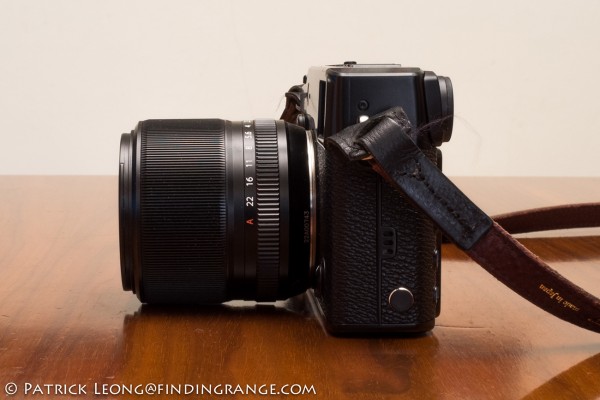
↑ Side view: XF 60mm F2.4 R Macro lens mounted on the Fuji X-Pro1.
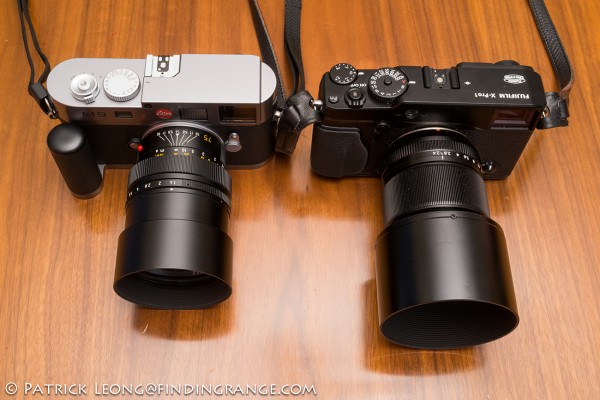
↑ 75 Summilux mounted on a Leica M9 vs. XF 60mm F2.4 R Macro lens mounted on a Fuji X-Pro1. The M9 has the M9 handgrip mounted on it. You can check out my review on the M9 handgrip.
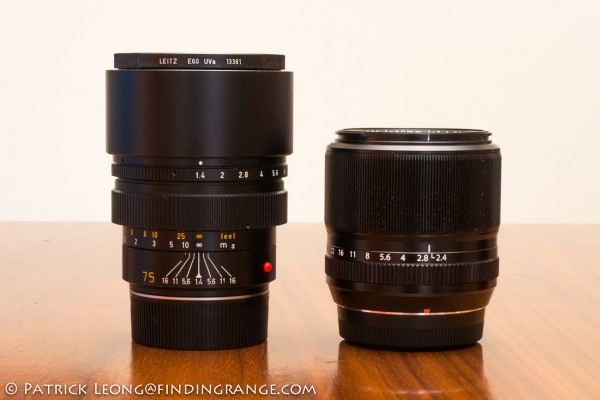
↑ Leica 75 Summilux vs. Fuji XF 60mm F2.4 R Macro lens without lens hoods. You can check out my Leica 75 Summilux review if you’re interested.
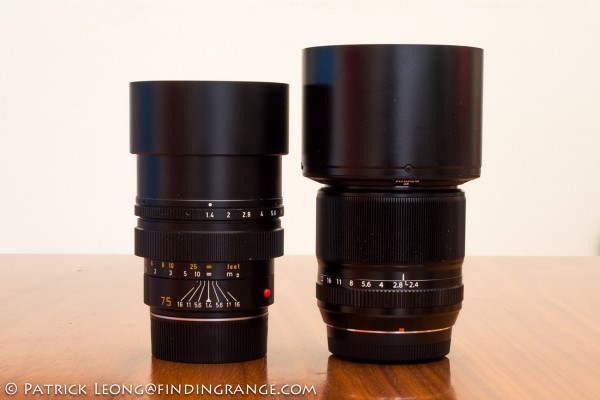
↑ Leica 75 Summilux vs. Fuji XF 60mm F2.4 R Macro lens with lens hoods.
The only real complaint that I have with this lens in terms of build is that I don’t really like the lens hood. The lens hood is so big that it makes it a bit inconvenient to carry around, and I don’t leave it permanently attached to the lens because there’s no cap for the lens hood. Plus, with the lens hood on, it makes the X-Pro1 a bit more conspicuous. My guess is that they made it so big to protect the front barrel of the lens. The internal lens barrel does comes out a bit when the lens is focusing. Who knows, all I know is that I leave my lens hood at home.
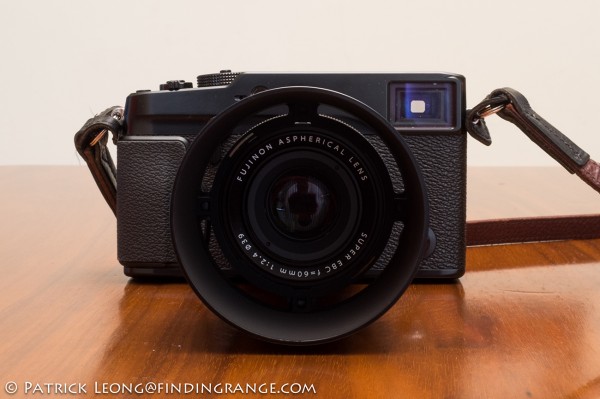
↑ Front view of the XF 60mm F2.4 R Macro lens with lens hood mounted on the X-Pro1.

↑ Side view of the XF 60mm F2.4 R Macro lens with lens hood mounted on the X-Pro1.
The Fujinon XF 60mm F2.4 R Macro Lens Sharpness, Detail, And Contrast:
Like the rest of the Fuji X-Pro1 lenses, image quality is top notch with the XF 60mm F2.4 R Macro lens. There is not much to complain about, and there probably aren’t enough adjectives to describe the remarkable quality of this lens, and the great photos that this lens can produce especially for its asking price. The XF 18mm is a great wide angle, and the XF 35mm is a phenomenal 50mm equivalent. How does the X-Pro1 90mm equivalent do? Well, this lens definitely fits in with the other two lenses as being a killer optic. Images are tack sharp even when photos are shot at the widest aperture, and they only get sharper when you reach F5.6 to F8. However, in my opinion, it’s very hard to tell the difference because at it’s widest aperture, this 60mm is already very sharp. Contrast is great, and colors coming out of this lens are deep, rich, and beautiful.

↑ The XF 60mm F2.4 R Macro lens is a great addition to the Fuji X-Pro1 system. This lens is very good at retrieving detail. 1/119 of a second at F2.4. Shot at 1000 ISO.
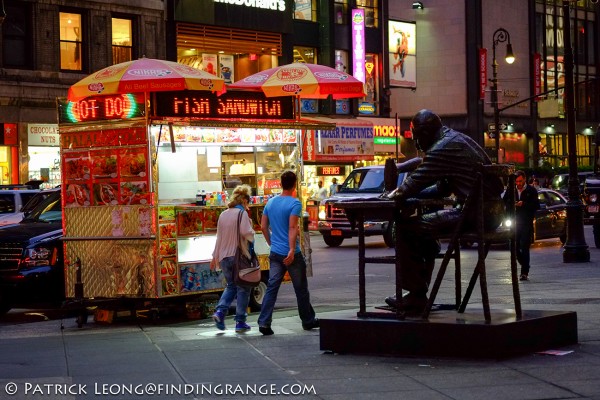
↑ Near Times Square shot at 2000 ISO wide open.
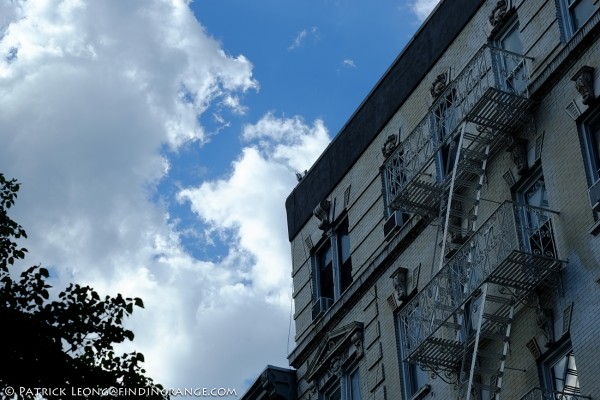
↑ Blue skies after a long period of rain here in New York City. 1/600 of a second at F8. Shot at 200 ISO.
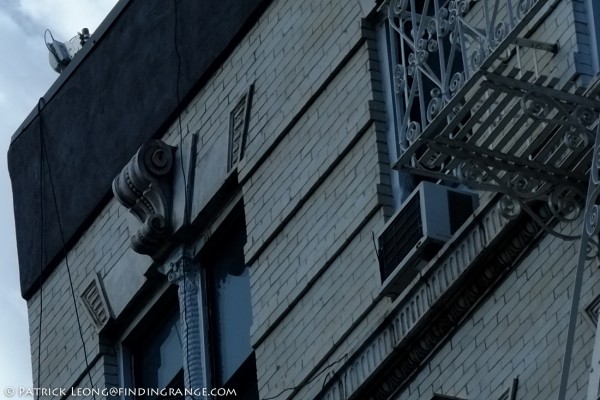
↑ 100% crop of the photo above.
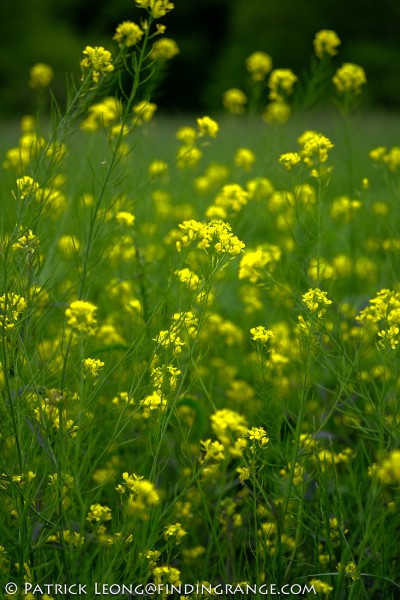
↑ Nice colors, smooth bokeh, sharp subject, and some three dimensional character: the hallmarks of the XF 60mm F2.4 R Macro lens.
While sharpness, color, contrast, and detail are excellent, the feature that I love the most from the XF 60mm F2.4 R Macro lens is that images have a nice velvety smoothness to them. Photos are still very three dimensional but also retain that nice, classy, and refreshing feeling that we all come to expect from a fine optic. Pictures taken with the 60mm and X-Pro1 combo never look overdone or like you’re trying too hard. In my opinion, they have a very nice, classic look to them. The smoothness reminds me of lenses that are much more expensive than this 60mm, which costs $649. I really love the unique signature of this lens, and I make every effort to use it even though I don’t generally use any lenses longer than a 50mm focal length for most of my daily shooting. I can’t see why anyone would be disappointed with this lens in terms of image quality.
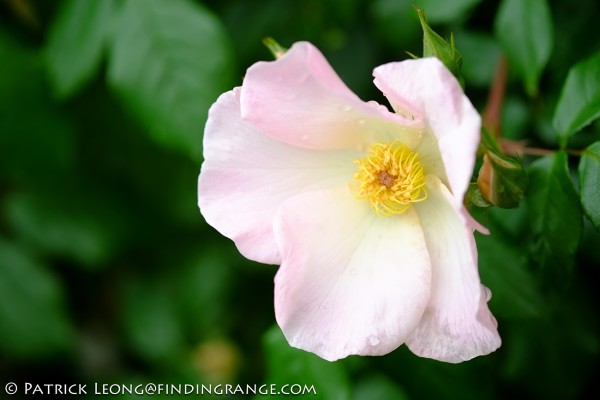
↑ The XF 60mm F2.4 R Macro lens is not only sharp; it also produces beautiful smooth photos with nice warm feeling colors.
Fujinon XF 60mm F2.4 R Macro Lens Bokeh:
With it’s nine curved aperture blades, you can be assured of very smooth background blur and nice round bokeh balls. In other words, the shallow depth of field is outstanding with the XF 60mm F2.4 R Macro lens. The bokeh from this lens is just so pleasing to look at, and just plain out beautiful. It is never overdone, and the shallow depth of field is never distracting yet it is so beautifully smooth! It has such a nice creamy, velvety, and classic look to it. The 35mm might have a slightly more shallow depth of field because of the F1.4 aperture (at least to my eyes) but trust me on this: there are no complaints with the 60mm. The bokeh is just so rich looking. It is so full bodied, and it is really something special..
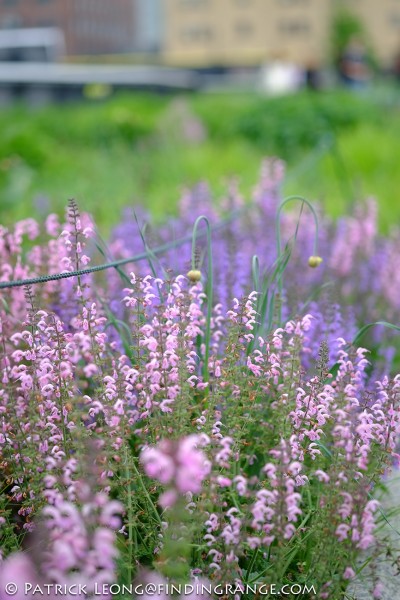
↑ The nine curved aperture blades help create beautiful bokeh.
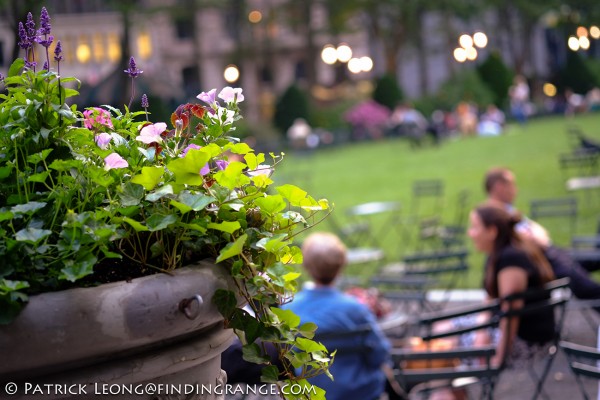
↑ More bokeh shots taken at 1000 ISO. I really like the bokeh from the XF 60mm F2.4 R Macro lens. The shallow depth of field is so smooth, and the photos from this lens still definitely have some pop to them.
↑ More smooth buttery shallow depth of field for all of you bokeh lovers out there.
↑ 100% crop of the photo above. The 60mm has nice shallow depth of field but it is still very sharp as demonstrated by the petals in this crop.
↑ One last photo demonstrating the smooth bokeh shapes.
Macro Shooting With the Fujinon XF 60mm F2.4 R Macro Lens:
I love using the XF 60mm F2.4 R Macro lens in macro mode. As I said before, this lens is very sharp, and it’s pretty amazing how much detail that you can get out of this lens especially when you use it up close. The great thing is that this lens can definitely get very close. Check out some of the samples below.
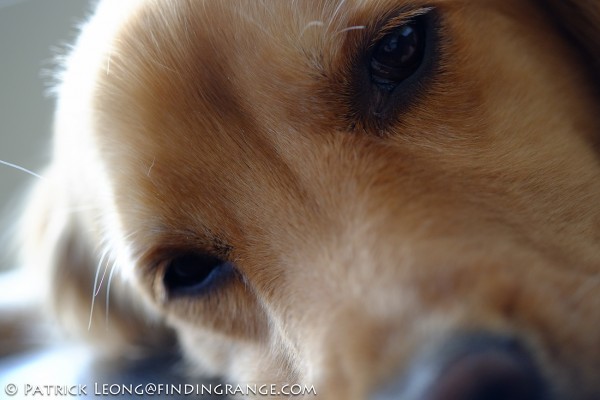
↑ An even closer shot of my brother in-law’s golden retriever in macro mode. This was shot at 1000 ISO.
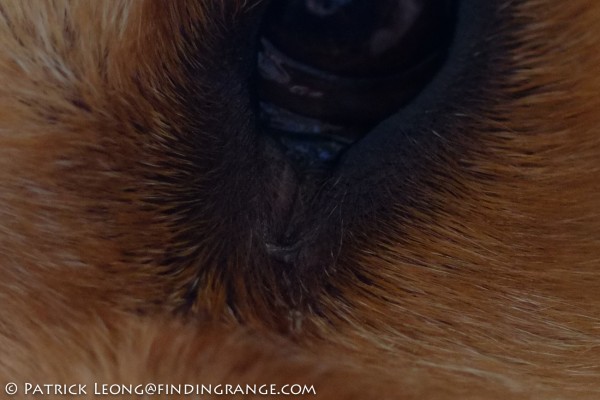
↑ A 100% crop of the photo above.

↑ Another 100% crop of the same photo. You can see the dust in the fur even though the eye was the focus point.
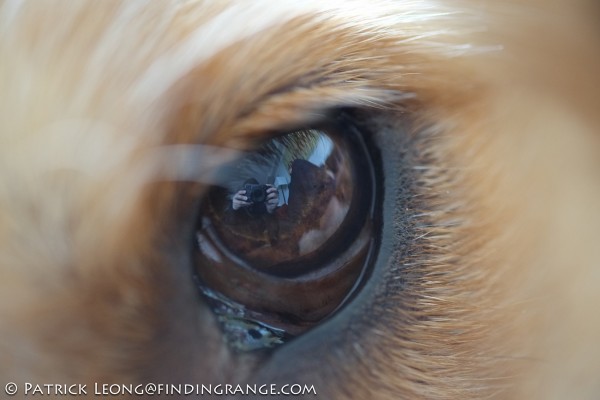
↑ You can get very close to your subject as demonstrated by this photo taken of the same golden retriever at 1/27 of a second hand held. You can see me holding the camera in the golden retriever’s eye, and this photo was shot at 2000 ISO! You really can’t fault the X-Pro1 for its high ISO capabilities.
The only bad thing is that when you shoot close, the autofocus can be a bit slow, and it can also incorrectly focus once in a while in low light situations. Everything in general is slower in function than let’s say, the XF 35mm. If this helps, I think of the XF 60mm as the SUV in the group of X-Pro1 lenses, and the XF 35 as the sport sedan. Yes, there are very fast SUV’s out there nowadays but SUV’s will always feel a bit bigger, and they will always feel a bit more sluggish. I’m not saying that the XF 60mm F2.4 R Macro lens is dramatically slower than the XF 35. I just want you to keep in mind that it is a bit slower than both of the other XF lenses that are currently out for the X-Pro1. Also, you have to be a bit careful because the inner lens barrel of the XF 60mm does extend out as it focuses. You don’t want to bang the front of your lens into your subject.
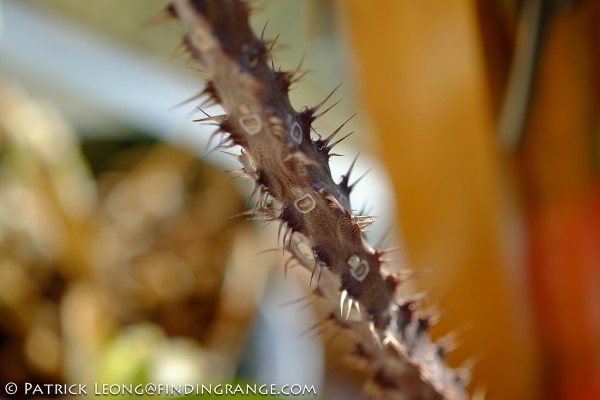
↑ A macro shot of a stem full of thorns shot at F2.4.
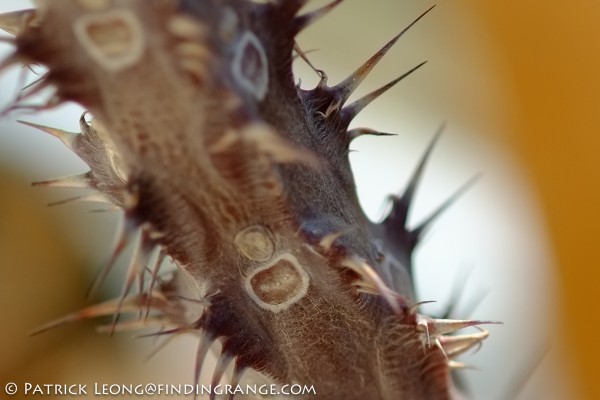
↑ 100% crop of the picture above.
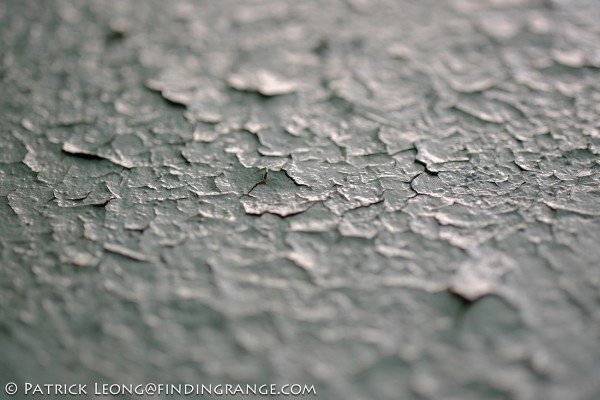
↑ Macro shot of a cracked wall shot at F2.4.
↑ A flowering plant filled with thorns shot wide open at 200 ISO.
 ↑ 100% crop of the photo above.
↑ 100% crop of the photo above.
↑ One last macro shot of a pink flower taken at F2.4. I love the vibrant colors, and smooth bokeh from this shot!
↑ Here is a 100% crop of the photo above.
Fujinon XF 35mm F1.4 R lens Vs. Fujinon XF 60mm F2.4 R Macro Lens:
Many of you who are reading this review might be wondering how the XF 60mm F2.4 R Macro lens really compares to the XF 35mm F1.4 R lens. Maybe some of you are contemplating on which lens to choose or maybe you all are wondering if the 60mm macro will complement your XF 35mm well. First off, the reason I love the 50mm focal length in general is because it is incredibly versatile, and to me, it’s actually the most versatile focal length out there. I know, I know, I’m a Leica guy so i should love the 35mm focal length but for those following my blog, don’t forget; I started out with a Leica M3, and the widest focal length in the viewfinder is a 50mm. With a good 50mm, you can shoot outstanding portraits, landscape, street, macro, and the list goes on and on. With the 90mm, you can do all of that but let’s be honest; it’s sometimes a bit harder with a long focal length.
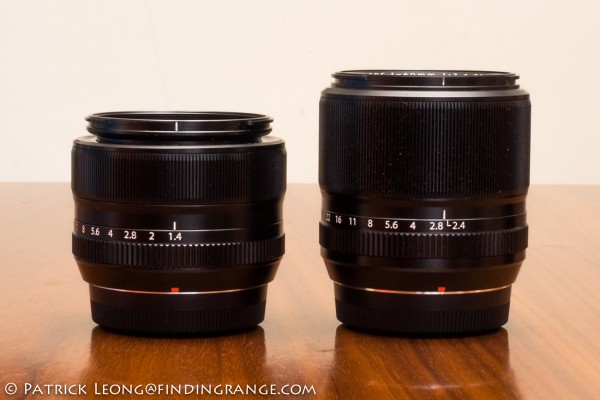
↑ XF 35mm F1.4 R lens vs. XF 60mm F2.4 R Macro lens.
The truth is, the XF 35mm F1.4 R lens is an awesome lens for the Fuji X-Pro1, and it is really hard to fault it, especially since it is so versatile. Many including me are completely content with just this one lens for the X-Pro1. It focuses faster than the 60mm, plus it’s more accurate in focusing. Being a shorter focal length, the 35mm is also naturally smaller than the 60mm especially with their lens hoods on. Lastly, it has a faster aperture than the 60mm. When I’m on the street with the XF 35mm and X-Pro1 combo, I just feel in sync. Everything seems right with the world, and I’m just having a great time :). I’m not really thinking, and I just get into this groove. If I only had one lens to choose from for my X-Pro1, it would most definitely be the XF 35mm F1.4 R lens. Honestly, I would probably buy the Fuji X-Pro1 just for the XF 35mm.
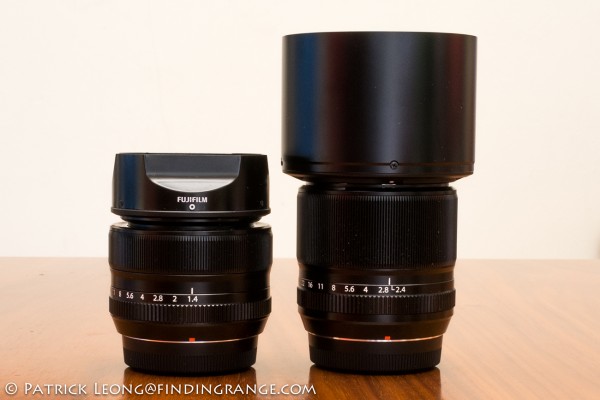
↑ XF 35mm F1.4 R lens vs. XF 60mm F2.4 R Macro lens with lens hoods.
But lets take the subject of portraits for instance. Both lenses will perform amazingly well with portraiture. With its longer focal length, the XF 60mm F2.4 R Macro lens was made for portraits. Do you remember earlier in this review when I mentioned that the XF 60mm has a really classy look to it? I wish I had more of a chance to photograph more portraits with this lens before I wrote this review because I think this one characteristic makes this lens completely worth it for portrait photography. The bokeh is so creamy looking. Images are so utterly smooth, and rich. But don’t discount the the XF 35mm. It has an aperture of F1.4, and believe me, it can make portraits look amazing as well. If I didn’t have the 60mm for portrait work, I would be perfectly content with the 35mm. The XF 35mm F1.4 is just so good…even if you shoot at smaller apertures, photos just pop. I’m not telling you to just stick with your XF 35mm, and not buy the 60mm. What I am saying is that both lenses have their own unique strengths that makes them great at portraits in their own unique way.
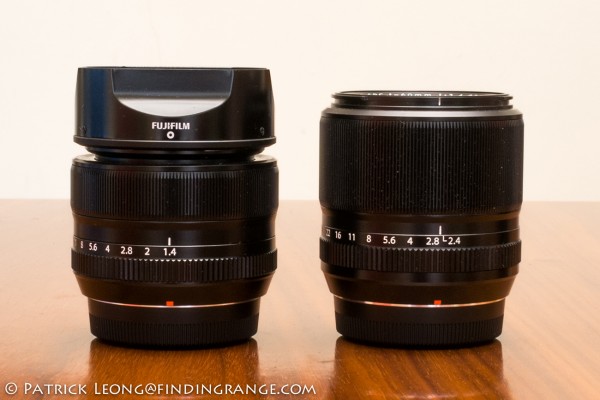
↑ XF 35mm F1.4 R lens with hood vs. XF 60mm F2.4 R Macro lens without hood.
For macro work, the XF 35mm F1.4 R lens still performs exceptionally well when compared with the 60mm. Again, it’s F1.4 aperture really helps the 35mm isolate its subject, and don’t forget; optically I still think that the 35mm is the best lens in the X-Pro1 system with the 60mm a very, very close second. But if you really need to get closer to your subject, then there is no substitute for the XF 60mm F2.4 R Macro lens. I never had a macro lens because I’ve used Leica M cameras all my life. I’m still quite surprised at how close I can get with the 60mm macro. It’s downright scary at times. This is something the 35mm can not do.
After saying all of that, what do I think are the differences between these two lenses? Well, in my opinion, I find the XF 35mm F1.4 R lens a bit more contrasty than the XF 60mm F2.4 R Macro lens. Shooting with the same settings on the X-Pro1, I also find that the colors and saturation from the 35mm F1.4 R lens are a bit punchier. In my opinion, I feel as if the 35mm is slightly more three dimensional but again, just a little. Some of this could also be due to the F1.4 aperture.
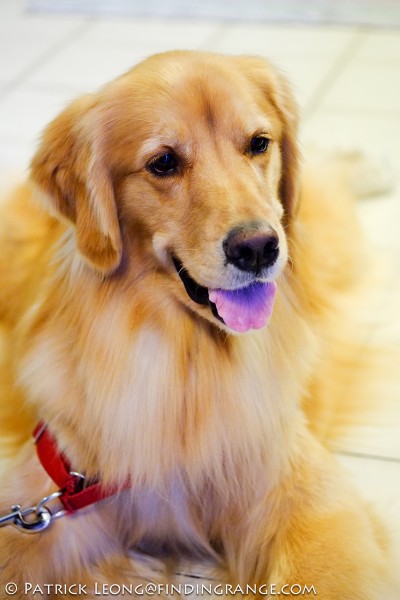
↑ This photo was shot at 1/60 of a second using 2500 ISO wide open.
These differences aren’t necessarily bad things; each of these lenses has its own unique signature. I personally love shooting with the 60mm because photos really have a nice elegance, and dare I say…maturity to them. I believe that the character of this lens really lends itself well to macro and especially portraiture. Photos just have this richness, and depth to them that keeps me coming back to the XF 60mm. While it’s there in the XF 35mm, it’s just more pronounced in the XF 60mm. The bokeh from the 60mm is just so creamy, and smooth looking. I love it. This lens can produce nice, soft, pleasing tones that really lends itself well to many types of photos that require an elegant look. Don’t mistaken soft, pleasing tones with a dull image. On the contrary, the XF 60mm F2.4 R Macro lens is incredibly bitingly sharp as well.
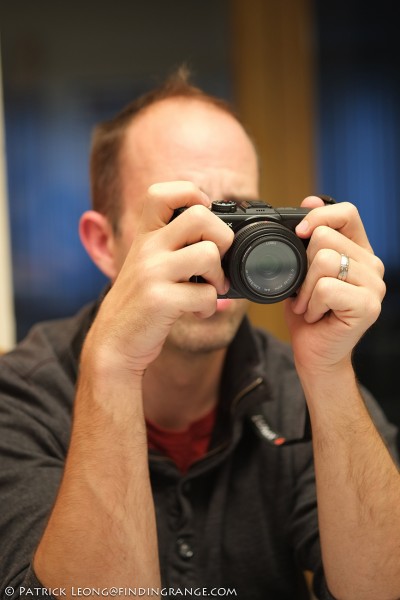
↑ My brother in law with a Panasonic GF1 and 20mm F1.7 combo.
That being said, if I could only own one lens, would I buy the XF 60mm over the XF 35mm? No, I would not buy the 60 F2.4 over the 35 F1.4. That makes sense though since I don’t want my only lens to be a 90mm equivalent :). I’ve been using this lens on my X-Pro1 exclusively for a few weeks to test it, and it’s been pretty difficult especially in the city when it’s sometimes hard to back up far enough to get a shot.
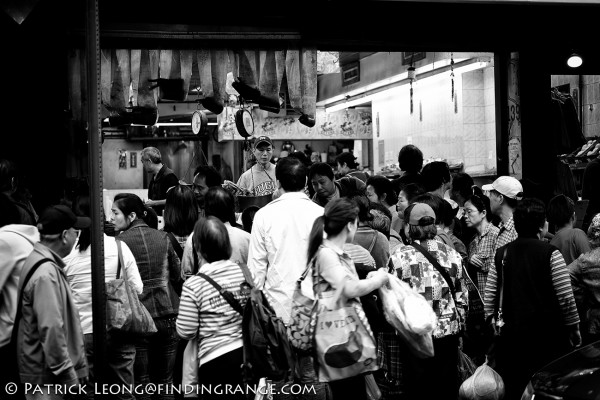
↑ Thanks to the longer focal length, I was able to get this photograph from across the street. This was processed with Nik Software Silver Efex Pro 2.
If I had the 18mm, would I buy the 60mm over the 35mm for a 28-90 equivalent combo? No, I wouldn’t because my favorite focal length is the 50mm. But that doesn’t mean that you shouldn’t consider the XF 60mm F2.4 R Macro lens over the 35mm if you already have the 18mm. You can use the 18mm for street shooting, you’re daily events, and pop the 60mm on your X-Pro1 when you need to take some portraits, macro or just to get closer. The 60mm Macro is definitely good enough optically where you can choose it over the 35mm based on necessity, and preference of focal length rather than because one is optically greater than the other. The 18mm and 60mm would make a killer combo for the Fuji X-Pro1.

↑ This was taken in Chinatown at 800 ISO wide open. The XF 60 Macro is a very three dimensional lens.
Things that I Don’t Like About The Fujinon XF 60mm F2.4 R Macro Lens:
The XF 60mm F2.4 R Macro lens is an excellent performer but there are some minor issues that I’ve already mentioned in this review. Here’s a recap:
1. Fujinon XF 60mm F2.4 R Macro Lens Lightness:
Just like the rest of the X-Pro1 system, the 60mm macro is light. It’s heavier than the other lenses but it is still on the light side. Some will like it, and some will not. I prefer a heavier lens but the good news is that this lightness in no way effects the quality of this lens. As mentioned before, this XF 60 F2.4 is built very well just like the rest of the X-Pro 1 system.
2. The Lens Cap For The Fujinon XF 60mm F2.4 Macro Lens:
I mention in both my XF 18mm F2.0 R lens review, and my XF 35mm F1.4 R lens review that I strongly disliked the rubber caps that go over the lens hoods. The lens cap that goes over the 60mm is not as annoying but it is still pretty dinky and small. It’s light, cheap, a little flimsy, and annoying to take off. Also, there is no cap that goes over the lens hood of the 60mm so if you want to use the hood, you have to screw it on every time you want to shoot with it.
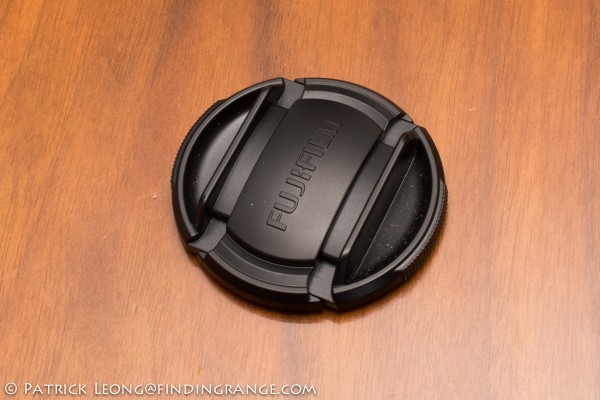
↑ Front of the lens cap.

↑ Back of the lens cap.
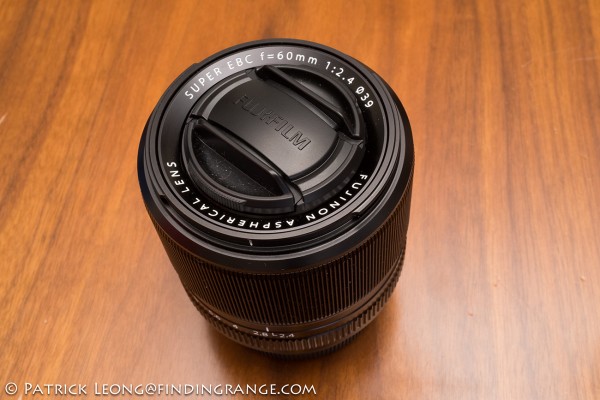
↑ Lens cap on the XF 60mm macro.
3. Fujinon XF 60mm F2.4 R Macro Lens Focusing Speed:
Focusing is bit slower than the other lenses in the X-Pro1 system. However, if you shoot at closer distances, the focusing does become noticeably slower.
4. XF 60mm F2.4 R Macro Lens Focus Issue:
When I’m using the XF 60mm, I sometimes end up focusing incorrectly. Sometimes, I will focus on one thing, and it ends up focusing on the background. This issue occured rarely but since this is a review, it’s worth mentioning.
Pro’s And Con’s of The Fujinon XF 60mm F2.4 R Macro Lens:
Pros of The XF 60mm F2.4 R Macro Lens:
- Bitingly sharp.
- Three dimensional.
- Colors and tones are velvety smooth and rich.
- Contrast is very nice.
- The nine curved aperture blades helps create rich, smooth, and velvety bokeh.
- A classy look to the photos.
- Lens is very light and well balanced on the X-Pro1.
- Relatively fast aperture of F2.4.
- Great Macro lens.
- Like the rest of the X-Pro1 system, this lens is a good build with no creaks, rattles or loose parts.
- Usually 90mm lenses are a bit heavy but this is a great one to carry around all day because of its lightness.
- A great price.
Cons of the XF 60mm F2.4 R Macro Lens:
- Like all the other X-Pro1 lenses, I don’t like the lens cap.
- The lens is a bit light for my tastes.
- I’m not a big fan of the internal lens barrel coming out so much.
- Autofocus generally a bit slower than the other two lenses in the X-Pro1 system.
- Slow autofocus in close range.
- On rare occasions, it can focus incorrectly.
Fujifilm Fujinon XF 60mm F2.4 R Macro Lens Verdict:
My verdict for the XF 60mm F2.4 R Macro lens is that it is a great lens with very few faults. If you want a little more reach than the 35mm, then do not hesitate to buy the 60mm because it is one awesome lens, and should satisfy many of your needs. In my opinion, the 35mm is the most versatile lens that you can buy for the Fuji X-Pro1. It can shoot portraits, macro, landscape, street, and whatever else you want to throw at it. I’m sure that many of you who own the wonderful XF 35mm F1.4 R lens with you X-Pro 1 are completely satisfied with the results especially with portraiture and macro ability. However, in my opinion, the XF 60mm F2.4 R Macro lens has its own distinct character that really makes this lens worth buying for your X-Pro1. The bokeh is incredibly rich and smoooth but the lens is also very sharp. In my opinion, this lens is a real gem, and priced very reasonably.

↑ A quick film strip of my uncle messing around. All the photos were taken at 640 ISO wide open. They were converted into black and white with Nik Software Silver Efex Pro 2.
There are a couple of issues that I’ve mentioned in this review but these do not effect the image quality at all. Yes, the autofocus is a bit slower especially when shooting at close distances but I wouldn’t be surprised if Fuji fixes this problem in the near future with a firmware update. With Leica prices dramatically going up, and Leica’s rumored interchangeable mirrorless a no show at this point, I wouldn’t be surprised if many photographers decide to invest in the Fuji X-Pro1 system. Now those photographers have another great lens to consider. The bottom line is that the XF 60mm F2.4 R Macro lens is an excellent performer, and if you don’t mind the minor hiccups associated with this lens, then this just might be the telephoto for you. Image quality is phenomenal. I seriously believe that it will make a great addition to any X-Pro1 system.
That’s it for this review, I hope you enjoyed it, and I hope it was useful to you :). All photos are jpegs straight out of the X-Pro1 with no photoshopping (with the exception of I think two or three) since the X-Pro1 RAW files are not yet compatible with Adobe Camera Raw. More stuff is coming very soon, so please stay tuned. Comments are always welcomed. Thanks for stopping by, and take care!
If you’re considering buying the Fuji X-Pro1, and my review helped you decide, please help support me by purchasing from one of the links below. Thank you for your support!
Fujinon 18mm F2.0 XF Lens From Amazon
Fujinon 35mm F1.4 XF Lens From Amazon
Fujinon 60mm F2.4 XF Macro Lens From Amazon
Fujinon 18mm F2.0 XF Lens From Adorama
Fujinon 35mm F1.4 XF Lens From Adorama
Fujinon 60mm F2.4 XF Lens From Adorama
If you haven’t yet, you can also check out my Fuji X-Pro1 review, my Fuji XF 18mm F2.0 R lens review, and my Fuji XF 35mm F1.4 R lens review. I also wrote a Fuji X-Pro1 HG-XPro1 Hand Grip review if you are interested.

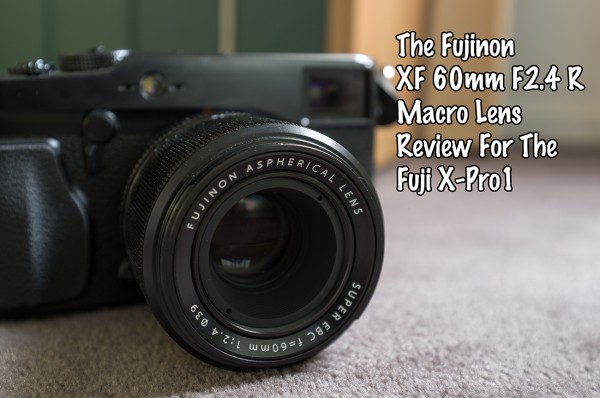
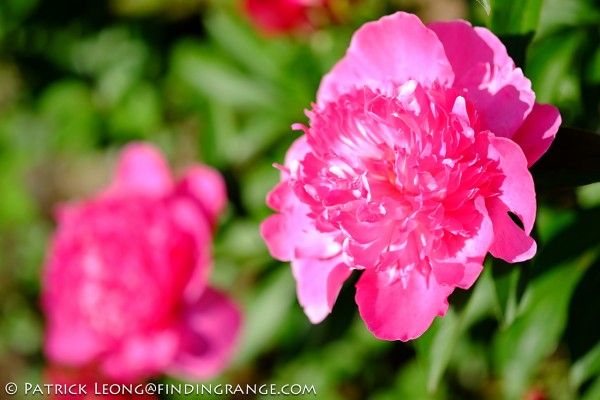
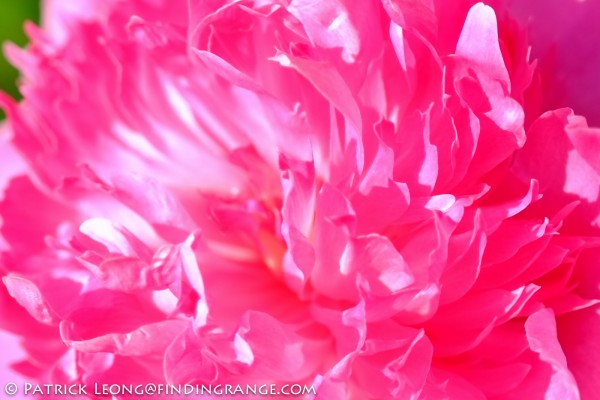
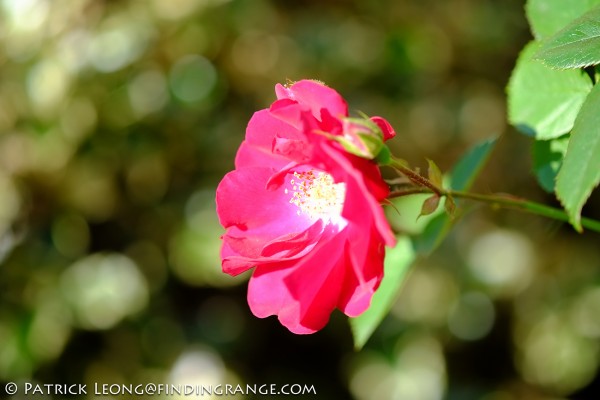
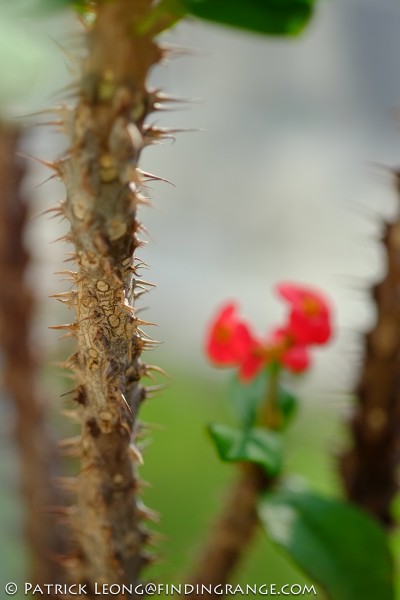
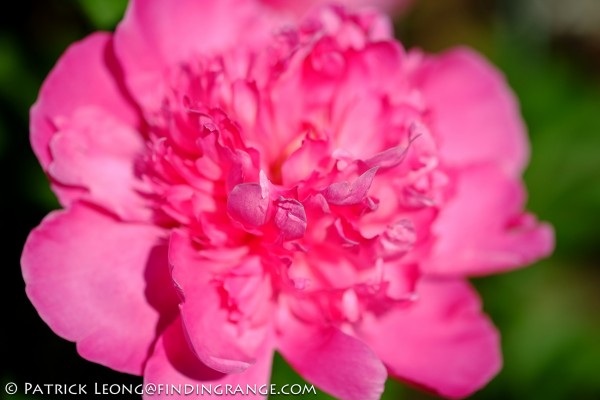
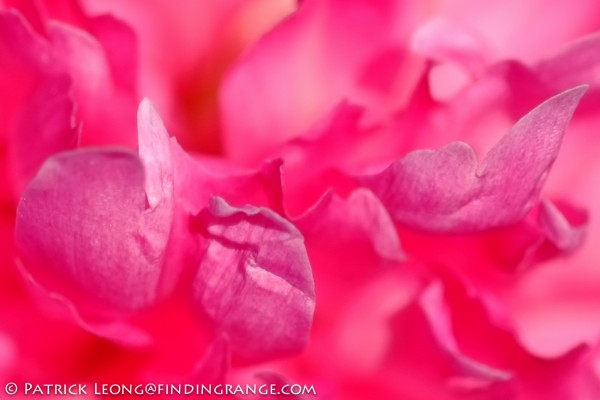
Very nice review, I might pick one up next week. What are your thoughts on the upcoming 56mm 1.4 for portraits? I do need a portrait and need to shoot some food macro photography so I think I’ll go with the 60mm.
Thanks Dane! It’s much appreciated! I’m thinking that the 56mm F1.4 is going to be one amazing piece of glass if it can match the quality of the 35mm. I definitely want to get one if the new Leica M doesn’t completely break the bank. So far, I’m loving the 35mm. But right now, I’m eagerly waiting for the new zoom to arrive (I pre-ordered an X-E1 kit). I heard great things about it, and definitely want to put it through its paces.
I seriously considered the EX1 with kit lens but I really miss the optical viewfinder of the X100. Would love to own a Leica and believe me I’ve been to the M’s site so may times trying to convince myself to get it. Not owning any Leica glass is the biggest deterrent, my wife will kill me if she finds out how much each cost hehe.
Yeah, I felt exactly the same way that you did. I had no interest in the X-E1 when it was first announced because I really love using an optical viewfinder. But while the X100 is one amazing camera, if it had to be a camera with a fixed lens, I wish Fuji gave us the option of choosing maybe a 50mm. With the X-E1, not only is it priced nicely, it is a great deal with the kit lens. Plus, it makes a great second body to the X-Pro1. I figured if I wanted to use an optical viewfinder, I could jump to the X-Pro1 or the M. The great thing about the X-E1 is that I can use the same lenses as my X-Pro1.
In terms of Leica stuff, I am a complete Leicaphile. I think it’s the best stuff out there but the prices are getting a bit out of hand. $7200 for a 50 F2? Yeah, it might be the best 50mm F2 in the world, and I won’t dispute that. But for a few thousand more, I might as well get a Noctilux. It’s crazy. I think my girlfriend will agree with your wife because she thinks that I am insane for ordering another M. But in Leica’s defense, the truth is, if you ever buy M glass, you will probably keep it forever because it’s really that good, and they’re simply indestructible. PLus, they only go up in value, and it’s pretty amazing how you can put old glass on something as new as an M9 or the new M. Do you ever think about buying used M glass (even for the Fuji M adapter)? Since M lenses are in stock now, used prices have finally dropped.
I need to check the used M glass market. I really want to shoot with legacy glasses. What would you recommend as a starter M lens that’s not too expensive for portraits?
Well, the Summarits are really good. Some people try to find fault with them because they are priced lower than other M lenses but optically they’re excellent. Hey, Leica finally made some lenses that are actually a bit more affordable, what’s wrong with that? 🙂 I had a 35 Summarit on loan from Leica, and it was definitely hard to let go. For portraits, you can buy the 90 Summarit new for $1900, and you can definitely find them used in great/mint condition for less. I’ve been wanting to write up a user review for it for quite some time but anything Leica related will probably have to wait until I get my new camera since I sold my M9. The great thing about all the Summarit line is that they’re small. They really follow the old Leica motto (small lenses that pack plenty of punch).
You can also try to get your hands on the 90 Elmarit used. I had the Elmarit a while back, and I regret selling it like crazy!!!! It’s really an excellent lens. You can also get the 90 Tele Elmarit F2.8 or as many call it, the pocket 90. It’s super portable, and it uses a E39 filter thread! I believe that you can get that under a thousand.
If you’re using these lenses on your X-Pro1, you might also want to try the 50 Summicron because of the crop factor. This is by far the best bang for your buck. This is one of Leica’s BEST lenses, and also one of the cheapest. I bought a 50 Summilux ASPH a while back, and I still can not bring myself to get rid of the 50 Summicron. I reviewed it a long time ago (http://findingrange.com/2012/02/24/the-leica-50-summicron-f2-0-lens-review/) but my review does not do this lens justice.
You can get the latest version for a very decent price used. There are plenty out there, which is a good thing. Small, built well, priced reasonably, RAZOR sharp…there are absolutely no complaints with this lens. I know you asked me for a starter lens but the 50 cron will probably be your starter, in-betweener, and last lens lol. If you get one, get the latest version (version 4). You can also get the previous one with the detachable hood since optically, it is the same. You can see a photo of it in my review.
If you are seriously considering used Leica lenses, you should check out Bergen County Camera. It’s where my family and I have been buying all of our Leica gear from for 30 years. Ask for Bob. He has a great used collection, and he doesn’t buy any junk so you won’t ripped off. Prices for used Leica glass are decent there, and he is very old school in the way he does business = very decent to the customer.
I hope some of this helps you out Dane. Feel free to comment back! Take care!
Thanks Patrick, I’ll check out the 50 Summicron. I need to stop buying guitars so I can concentrate on building up my Fuji/M glass collection. Or sell my guitars….
Serious, you can’t go wrong with a 50 Summicron. The one with the built in hood usually costs a lot more than the previous one with the detachable hood but it’s the same lens optically. But before you buy another lens, don’t forget, Zeiss is coming out with autofocus lenses for the X mount!
Ohh I went to Bergen Camera online and saw a M9 used, is that your camera hehe?
Lol, no my camera is a Grey Steel one. He still has it for $4500. I heard someone was checking it out the other day. It’s actually a bit weird feeling because I still feel like it’s my camera (It technically is since it’s on consignment).
Nice write up, thanks! Just remember, a 35mm on a crop sensor is equivalent to a 50mm in angle of view only! Optically, it is still a 35mm focal-length lens so your bokeh (DOF) will be that of a 35mm. The 60mm 2.4 will always have shallower DOF than the 35mm 1.4 at the same distance to subject – it’s just math.
Thanks Dave!
Hi Patrick,
I got this lens about two weeks ago. It has a small learning curve. Well, for me it did. Now that I’m past that I’m very happy with it. While I have several other Fuji lenses that all seem to focus faster, I find that for the kind of work I like to do there is no problem with the slower focusing speed. Opening the lens to f2.4 gives a nice shallow depth of field which is nice. I also like the fact the the lens is nice and compact. I’ve handled the 80mm and it is large and heavy. My favorite magnification setting is 1/3 life-size so I don’t miss anything with the lack of getting beyond 1/2.
Cheers,
Steve
Hi Steve,
I owned this lens quite a long time ago. In fact, the copy in this review was mine :). I remember it being quite sharp and handy.
The size is definitely nice. In addition to its macro capabilities, it makes a great portrait lens. I’m glad that you’re enjoying it. I’d love to see some photos whenever you have a chance :). Happy holidays,
Best,
Patrick